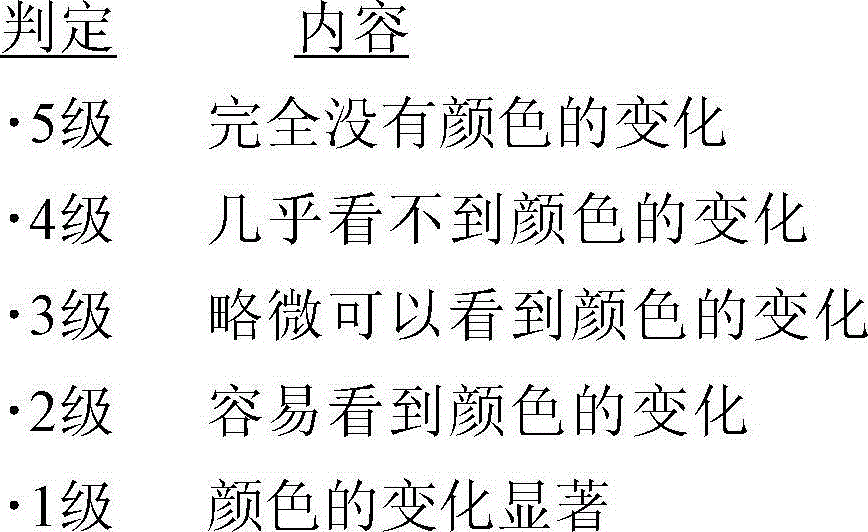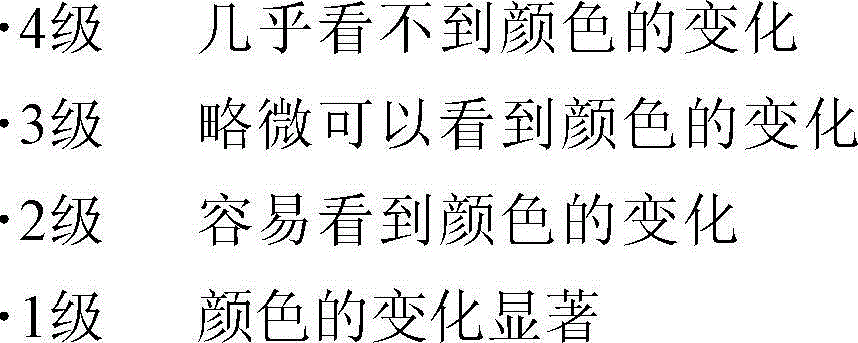Anti-allergen fibrous product and allergen reduction-processing agent
A fiber product, allergenic technology, applied in the field of fiber products, to achieve the effects of excellent friction fastness, improved friction durability, and high friction fastness
- Summary
- Abstract
- Description
- Claims
- Application Information
AI Technical Summary
Problems solved by technology
Method used
Image
Examples
Embodiment 1
[0126] In view of the results of Test Example 5, the adhesive was further studied for the purpose of improving the rubbing fastness. As shown in Table 6, the test was performed while changing the adhesion amount of the antiallergen agent and adhesive. The cloth used and the method of treating the cloth were the same as in Test Example 5.
[0127] The chemicals used are described below.
[0128] α-zirconium phosphate: Allelimob ZK (particle size: 0.8 to 1.3 μm) manufactured by Toagosei Co., Ltd.
[0129] Aromatic compound having a sulfonyl group (polymer containing an aromatic sulfonium salt): SSPA manufactured by Sekisui Chemical Industry Co., Ltd.
[0130] Acrylic resin: NUKOTE ACR (glass transition point -20° C.) manufactured by Shin-Nakamura Chemical Industry Co., Ltd.
[0131] Polyester-based resin: PLUS COAT Z manufactured by Hoyo Chemical Industry Co., Ltd.
[0132] Table 6
[0133]
[0134] As shown in Table 6, when acrylic resin is used and the amount of adhesi...
Embodiment 2
[0137] Flame retardancy was evaluated about sample number 1 (no adhesive) and sample numbers 5 and 7 to 9 (using acrylic adhesive) of Example 1. The results are shown in Table 7. "Comprehensive evaluation" in Table 7 shows the evaluation results in consideration of both the test in Table 6 and the flame retardancy test in Table 7.
[0138] In addition, the allergen inactivation rate after application of the allergen was measured for the fabric of sample number 8 (F method). Method F is an evaluation method different from methods A to E (in which a sample for evaluation is put into a solution containing an allergen and measured) in that the allergen inactivation rate is measured in a dry state. An evaluation method that is more in line with the usual way of use. The results are shown in Table 7.
[0139] Table 7
[0140]
[0141] As shown in Table 7, the adhesion amount on the acrylic resin is 0.2g / m 2 In the following cases, the fabric exhibits self-extinguishing prope...
Embodiment 3
[0145] As shown in Table 8, the whitening of the fabric when the α-zirconium phosphate and the aromatic compound having a sulfonyl group were attached to the fabric was measured. The cloth used and the processing method of the cloth were the same as in Test Example 5. The L value and ΔE value in the table were measured using an SM color computer (manufactured by Suga Test Instruments Co., Ltd.). In addition, the higher the degree of whitening of the fabric, the larger the ΔE value. The components used are the same as in Example 1.
[0146] Table 8
[0147]
[0148]As shown in Table 8, when zirconium phosphate is used in combination with an aromatic compound having a sulfonyl group (sample numbers 13 and 16), the ΔE value becomes smaller than when zirconium phosphate is used alone (sample numbers 12 and 15). , it was seen that whitening was reduced by using the two formulations in combination. In addition, when an acrylic resin was used as a binder (sample numbers 14 and...
PUM
| Property | Measurement | Unit |
|---|---|---|
| Adhesion amount | aaaaa | aaaaa |
| glass transition temperature | aaaaa | aaaaa |
| particle size | aaaaa | aaaaa |
Abstract
Description
Claims
Application Information
 Login to View More
Login to View More - R&D
- Intellectual Property
- Life Sciences
- Materials
- Tech Scout
- Unparalleled Data Quality
- Higher Quality Content
- 60% Fewer Hallucinations
Browse by: Latest US Patents, China's latest patents, Technical Efficacy Thesaurus, Application Domain, Technology Topic, Popular Technical Reports.
© 2025 PatSnap. All rights reserved.Legal|Privacy policy|Modern Slavery Act Transparency Statement|Sitemap|About US| Contact US: help@patsnap.com



